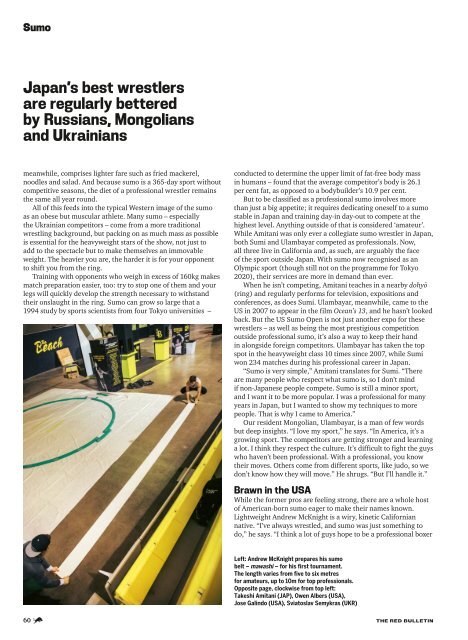You also want an ePaper? Increase the reach of your titles
YUMPU automatically turns print PDFs into web optimized ePapers that Google loves.
Sumo<br />
Japan’s best wrestlers<br />
are regularly bettered<br />
by Russians, Mongolians<br />
and Ukrainians<br />
meanwhile, comprises lighter fare such as fried mackerel,<br />
noodles and salad. And because sumo is a 365-day sport without<br />
competitive seasons, the diet of a professional wrestler remains<br />
the same all year round.<br />
All of this feeds into the typical Western image of the sumo<br />
as an obese but muscular athlete. Many sumo – especially<br />
the Ukrainian competitors – come from a more traditional<br />
wrestling background, but packing on as much mass as possible<br />
is essential for the heavyweight stars of the show, not just to<br />
add to the spectacle but to make themselves an immovable<br />
weight. <strong>The</strong> heavier you are, the harder it is for your opponent<br />
to shift you from the ring.<br />
Training with opponents who weigh in excess of 160kg makes<br />
match preparation easier, too: try to stop one of them and your<br />
legs will quickly develop the strength necessary to withstand<br />
their onslaught in the ring. Sumo can grow so large that a<br />
1994 study by sports scientists from four Tokyo universities –<br />
conducted to determine the upper limit of fat-free body mass<br />
in humans – found that the average competitor’s body is 26.1<br />
per cent fat, as opposed to a bodybuilder’s 10.9 per cent.<br />
But to be classified as a professional sumo involves more<br />
than just a big appetite; it requires dedicating oneself to a sumo<br />
stable in Japan and training day-in day-out to compete at the<br />
highest level. Anything outside of that is considered ‘amateur’.<br />
While Amitani was only ever a collegiate sumo wrestler in Japan,<br />
both Sumi and Ulambayar competed as professionals. Now,<br />
all three live in California and, as such, are arguably the face<br />
of the sport outside Japan. With sumo now recognised as an<br />
Olympic sport (though still not on the programme for Tokyo<br />
2020), their services are more in demand than ever.<br />
When he isn’t competing, Amitani teaches in a nearby dohyō<br />
(ring) and regularly performs for television, expositions and<br />
conferences, as does Sumi. Ulambayar, meanwhile, came to the<br />
US in 2007 to appear in the film Ocean’s 13, and he hasn’t looked<br />
back. But the US Sumo Open is not just another expo for these<br />
wrestlers – as well as being the most prestigious competition<br />
outside professional sumo, it’s also a way to keep their hand<br />
in alongside foreign competitors. Ulambayar has taken the top<br />
spot in the heavyweight class 10 times since 2007, while Sumi<br />
won 234 matches during his professional career in Japan.<br />
“Sumo is very simple,” Amitani translates for Sumi. “<strong>The</strong>re<br />
are many people who respect what sumo is, so I don’t mind<br />
if non-Japanese people compete. Sumo is still a minor sport,<br />
and I want it to be more popular. I was a professional for many<br />
years in Japan, but I wanted to show my techniques to more<br />
people. That is why I came to America.”<br />
Our resident Mongolian, Ulambayar, is a man of few words<br />
but deep insights. “I love my sport,” he says. “In America, it’s a<br />
growing sport. <strong>The</strong> competitors are getting stronger and learning<br />
a lot. I think they respect the culture. It’s difficult to fight the guys<br />
who haven’t been professional. With a professional, you know<br />
their moves. Others come from different sports, like judo, so we<br />
don’t know how they will move.” He shrugs. “But I’ll handle it.”<br />
Brawn in the USA<br />
While the former pros are feeling strong, there are a whole host<br />
of American-born sumo eager to make their names known.<br />
Lightweight Andrew McKnight is a wiry, kinetic Californian<br />
native. “I’ve always wrestled, and sumo was just something to<br />
do,” he says. “I think a lot of guys hope to be a professional boxer<br />
Left: Andrew McKnight prepares his sumo<br />
belt – mawashi – for his first tournament.<br />
<strong>The</strong> length varies from five to six metres<br />
for amateurs, up to 10m for top professionals.<br />
Opposite page, clockwise from top left:<br />
Takeshi Amitani (JAP), Owen Albers (USA),<br />
Jose Galindo (USA), Sviatoslav Semykras (<strong>UK</strong>R)<br />
60 THE RED BULLETIN

















